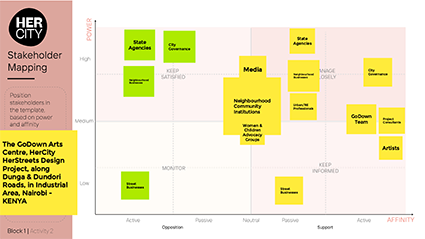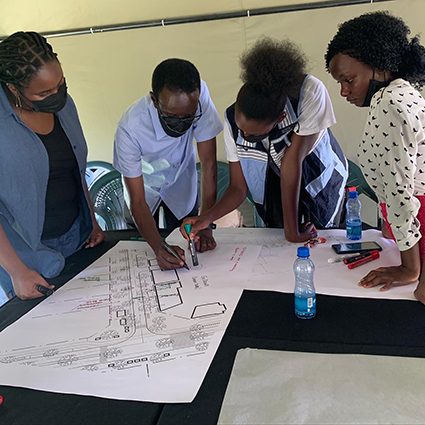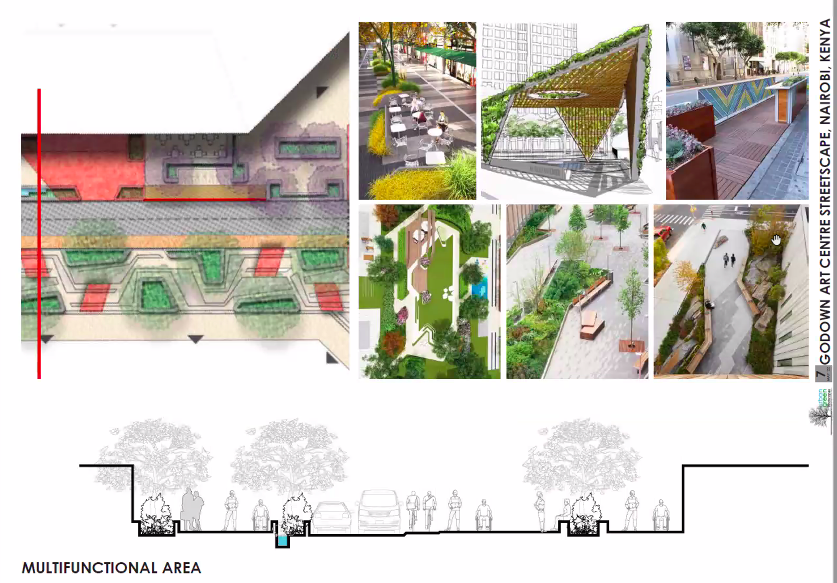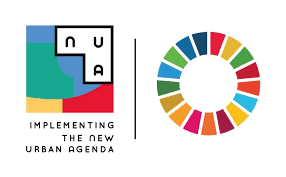Impact Story
Nairobi
In the GoDown Her City project “#HerStreets”, a part of the wider GoDown Transformation Project, focus is to make the the art centre a place for everyone. The HerCity#HerStreets project aims to improve the streets around the upcoming New GoDown Cultural Arts Complex, to make them safer and more inclusive public spaces, accommodating a diversity of shared commercial, social, and cultural activities. These street improvements are a continuation of studies started in 2011, carried out in conjunction with UN-Habitat and The GoDown is partnering with White Arkitekter and Planning Systems, exploring the possibility of creating a Cultural Axis in the Industrial Area of Nairobi.
Facts

Category: Public and Private Partnership
Location: Dunga road and Dundori road, Industrial Area, Nairobi County, Kenya.
Time: June 2021 – December 2023
Partners: GoDown Arts Centre, UN-Habitat, Global Utmaning, Planning Systems, White Architects
Participants: Primary core of women & girls from the neighbourhood, street vendors and universities. Secondary group of business owners, residents, students from Mariakani primary school and Nairobi urbanist community.
Her story
Challenges
In Nairobi more generally, the streets are currently dominated by two uses; vehicular traffic and different forms of private business activities such as street vending or customer parking. These private business activities are often done in an uncontrolled and haphazard manner, leaving little room for other uses. As a result, pedestrian movement is one of the most hazardous uses of streets in the city. Vulnerable pedestrian groups such as girls are particularly disadvantaged when trying to navigate the city, due to harassment, insecurity, lack of public washrooms, among many other challenges. This is the case in the Industrial Area and two streets of Dunga and Dundori Road are examples of the challenges facing the different competing interests in the streets. The GoDown is also committed to community-centred engagement and participatory processes for sustainable urban development. This is demonstrated in its on-going Transformation Project. The Transformation Project involves the re-development of The GoDowns 1.6 acre property in Industrial Area, from 7,000 Sq.M of adaptive reuse/renovated warehouses, to transform into a 25,000 Sq.M mixed-use public purpose development – a New GoDown Cultural Arts Complex that responds to the latent opportunities culture holds for Nairobi City. The GoDown’s HerCity#HerStreets project aims to promote the idea of streets as safe and inclusive public spaces in the city, by showcasing the possibilities of the two streets of Dunga and Dundori Road to carry a diverse variety of uses, such as arts and culture programming, street vending and business parking, while at the same time ensuring safe mobility for all.
Solutions
The GoDown’s Her City #HerStreets project involves the deployment of the step-by-step inclusive methodology of UN Habitat’s Her City toolbox. As such, activities have been conducted with a primary group of women and girls composed of residents, street vendors, students and recent university graduates in built environment studies. The participants conducted exploratory walks in the neighbourhood, observing the five dimensions of public space: use & users, accessibility, amenities & furniture, comfort & safety, and the green environment. Other stakeholders engaged in secondary activities include pupils from the local primary school, neighbourhood property owners and the Nairobi urbanist community. Following data gathering, a Method-Kit brainstorming workshop identified challenges in the space and created a joint vision forward.
Opportunities
With the help of the computer game Minecraft, the visions were taking shape through innovative design suggestions made by the participants. The user-friendly game enables people without previous experience in Minecraft or design of public spaces to visualise their design suggestions. Therefore, this Her City project enabled participants to develop their IT skills and design competence. The design suggestions ranged from public toilets, urban orchards and mazes, fountains and ponds, free libraries, cycle lanes, interactive pavements, spaces for exhibition and performance, fun parks and public seating. One proposal featured a grand entrance from Dunga Road, in the form of a labyrinth of floral bushes that takes you into the New GoDown Arts Complex, through the open courtyard, the foyer and into the performance auditorium. Many of the design suggestions that were made by the primary group of girls during the Minecraft workshop incorporated art elements on streets and walls, for example graffiti walls, art exhibits on the outside of the walls of buildings and sculptures.
Impact
The project shows that Her City toolbox can help shape resilient cities together with local communities. The girls have envisioned a more lively area around the GoDown centre featuring more greenery, more art and public meeting places that can benefit all Nairobians. Furthermore, the project has enabled participants and experts, through the visualisations in Minecraft, to look at the same space and communicate with a common ground. From about 20 scheduled Her City activities ranging from large community meetings, to data collection walks and small office meetings, 200 community members have actively participated in the project. Furthermore,GoDown outreach activities have engaged more than 500 members of the general public via social media and other communication channels. The project has laid the seeds for collective action in the neighbourhood. The Her City #HerStreets Project has been key to helping The GoDown to catalyse the development of the surrounding neighbourhood. An improvement of the streets to function as better public spaces would enable the further definition of the area as a Cultural Destination. The project has also allowed The GoDown to continue its community building efforts by bringing together different stakeholders in the neighbourhood. This community-centred engagement has been a strategic aim of The GoDown to enhance the agency and engagement of diverse demographics in urban issues that impact their quality of life and socio-economic opportunities. Consequently, this aims to strengthen local ownership towards public spaces such as The New GoDown and its surrounding streets, as a crucial step towards a more sustainable urban environment for Nairobi.
Lessons learned
Participatory processes require negotiations across the interests of different stakeholder groups. While they also offer the opportunity to include vulnerable groups, the process has shown that keen attention must be paid to the variety of voices and interests in the community. Digital tools such as the Kobo App and Minecraft have been key in ensuring active participation of stakeholders by allowing the direct capture of their observations and proposed solutions. The GoDown project particularly shows the possibility of combining arts and culture to empower young women. The Her City philosophy concludes that a city shaped by girls is a city that works for everyone. While outcomes of participatory processes are important, so is the process: methodologies itself. In this case, having a diverse set of participants (unlike prior case studies), what were the challenges and opportunities. Were the methodologies employed significantly different than say working with a group of girls from a nearby village? How did the team integrate different perspectives and encourage negotiation between the user groups? The GoDown contributes to more than five SDGs: Through the inclusion of women; The consideration in design of the importance of diverse economic productivity from street businesses and formal businesses; Developing streets as public spaces that should be designed as sustainable and resilient infrastructure that support economic development and wellbeing through; The enhancement of inclusive participatory planning that enables universal access and promotes green public spaces and; Global partnerships for sustainable development, knowledge and expertise exchange.
Results

Block 1: Stakeholder engagement
A multi-stakeholder team of girls and professionals to mainstream youth, gender and socio-economic perspectives throughout the entire planning, design and implementation process.

Block 2: City wide assessment
A city level analysis based on girls and young women’s observations and a list with their top priority spaces to be improved.

Block 3: Site specific assessment
Collecting quantitative and qualitative data by girls and young women on the state of the space that is considered a top priority for improvement.

Block 4: Analysing challenges
A joint vision for the space based on a detailed analysis of the girls’ needs and current privileges in the space.

Block 5: Designing ideas
A rough design in Minecraft of the new space made by the girls and professionals based on the solutions identified throughout the process.

Block 7: Action plans
Detailed plans collaboratively developed by the girls and professionals for the construction phase including cost estimations and maintenance plans.

Block 8: Sharing results
Approval to move forward and start construction from decision-makers and community and spreading of knowledge gained throughout the project.

Block 9: Implementation and follow-up
An evaluation of the process, follow up on construction by the girls and a final report on the results of the entire project with a mainstreaming strategy to scale up similar initiatives.
Related SDGs

The project relates to the 2030 Agenda Sustainable Development Goals (SDGs) 5, 8, 9, 11 and 17.
About
Contact
hercity@un.org
Follow us
Facebook: @HerCity
Instagram: @HerCityToolbox
Twitter: @HerCityToolbox
YouTube: @HerCity
TikTok: @HerCity
#HerCity
Her City is a joint urban development initiative by UN-Habitat (the United Nations Human Settlements Programme) and Shared City Foundation.